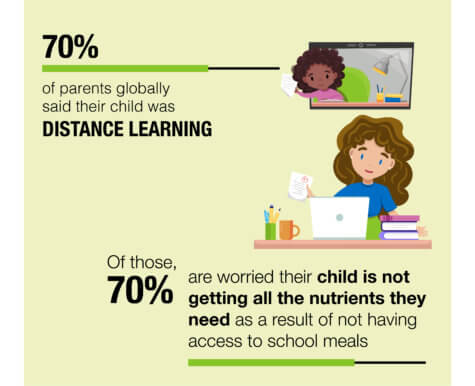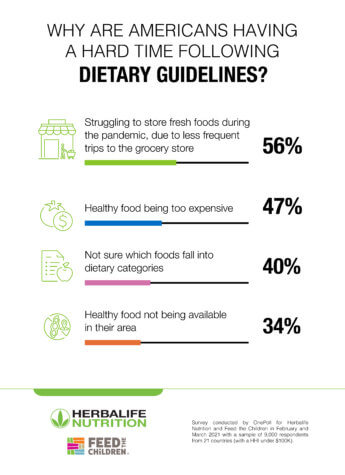NEW YORK — While hunger and poverty are not new issues in America, a new study finds many are facing these challenges for the first time during the coronavirus pandemic. Six in 10 Americans say they have faced “food insecurity” at some point in their lives. Of those, 73 percent experienced it for the first time since the start of the current crisis.
The survey of 2,000 Americans with an annual household income under $100,000 finds 35 percent who have faced food insecurity say they’ve had to skip meals during their struggles. The USDA defines food insecurity as a “lack of available financial resources for food for all members of the home.”
Thirty-one percent said they didn’t know where their next meal would come from. Another 32 percent of those who experienced food insecurity said they didn’t have enough money to buy food. Conducted by OnePoll on behalf of Herbalife Nutrition and Feed the Children, the survey looked not only at how food insecurity affects Americans but also at its global impact.
Food insecurity around the world
The survey, including over 9,000 respondents from 21 countries, reveals that the effect of the pandemic on food insecurity globally is less severe than in the U.S. Globally, researchers find 49 percent have experienced food insecurity during their lives. Of those, 61 percent experienced it for the first time since the start of the pandemic.
 “Access to affordable healthy food should be the norm for every person but, tragically, we find ourselves in a global crisis that needs our attention with more than 820 million people around the world living in hunger, a crisis that has been compounded by the pandemic,” says Dr. Kent Bradley, Chief Health and Nutrition Officer at Herbalife Nutrition, in a statement.
“Access to affordable healthy food should be the norm for every person but, tragically, we find ourselves in a global crisis that needs our attention with more than 820 million people around the world living in hunger, a crisis that has been compounded by the pandemic,” says Dr. Kent Bradley, Chief Health and Nutrition Officer at Herbalife Nutrition, in a statement.
For those in the survey, their concern isn’t only for themselves. In fact, 58 percent of respondents globally are parents and for those who have experienced food insecurity, 88 percent are worried their child will have lasting health effects as a result of food insecurity during COVID.
Seventy percent of parents globally said their child is currently going to school virtually. Of those parents, about six in 10 said they typically rely on schools to ensure their child is eating healthy meals. With that in mind, 70 percent worry their child is not getting all the nutrients they need as a result of not having access to school meals while learning from home.
“In the U.S. one in four children are living in a food insecure household,” says Travis Arnold, President and CEO of Feed the Children, a nonprofit organization focused on alleviating childhood hunger. “Many children who are no longer attending childcare centers or in-person school have limited access to school meals — a source of nutritious meals for millions of students across the country.”
“Since food insecurity and poor nutrition are associated with several chronic illnesses, the food access crisis threatens to intensify the disparities in health for at-risk children and families,” Arnold continues.
Parents want better access to school meals
More than three in four American respondents (78%) believe school meals should be available free of charge. The same number believe the country should eliminate “meal debt” from schools. However, school meals are only one piece of healthy eating and researchers find 60 percent of global respondents said they struggle to eat a diet that aligns with their country’s national dietary guidelines.
 Part of the problem might be because respondents are unaware of their country’s national dietary guidelines. In the U.S., 45 percent of respondents still believe the classic food pyramid represents the current nutritional guidelines. That’s actually out of date, as the current guidelines use a circle, or a “food plate.”
Part of the problem might be because respondents are unaware of their country’s national dietary guidelines. In the U.S., 45 percent of respondents still believe the classic food pyramid represents the current nutritional guidelines. That’s actually out of date, as the current guidelines use a circle, or a “food plate.”
Even when seeing a photo of the food plate, a third of American respondents (36%) still struggled to identify which section represented each food group. They were most likely to correctly place vegetables (29%) on the food plate and least likely to correctly identify where fruits belong (6%).
“Understanding the guidelines for a healthy balanced diet is important and we need, as a human race, to ensure that people all over the world have access to affordable healthy foods,” adds Dr. Bradley.
American respondents reported other struggles with meeting nutritional standards, beyond not knowing what those recommendations are. For those respondents, they reported having a harder time storing fresh foods during the pandemic, due to less frequent trips to the grocery store (56%).
That’s in addition to healthy food being too expensive for many to afford (47%), not being sure which foods fall into each of those categories (40%), and healthy food not being available in their area (34%).
